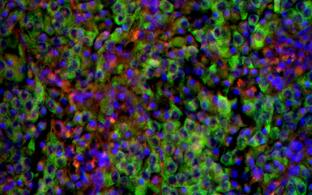
Dörr Lab
Tumor heterogeneity and treatment resistance in pediatric cancer
Profile
Despite the development of targeted therapies, treatment resistance remains a critical barrier to curative cancer therapies. Treatment resistance may be caused by mutations of tumor suppressor genes in tumor subpopulations, but also by differential expression of oncogenes, such as RAS or MYC(N), on extrachromosomal DNA within the tumor. This intratumoral heterogeneity can spatially influence cell fate decisions after cancer therapy, such as the induction of senescence or apoptosis, and locally alter the tumor biology and the tumor environment. In our group scientists and physicians work together to investigate how intratumoral differences in oncogene dosage alter tumor physiology and contribute to treatment resistance in pediatric malignancies. We believe that understanding tumor heterogeneity at single cell level will offer diagnostic tools and identify new therapeutic opportunities for the detection and treatment of resistant tumor populations, particularly with senescence-targeting therapies
Team
Group leader
Jan Rafael Dörr
Jan Rafael Dörr@mdc-berlin.de
Scientists
Dr. Giulia Montuori
Dr. Bartolomeo Bosco
Bartolomeo.Bosco@mdc-berlin.de
Marie-Florence Kiefer
Medical students
Lara Fankhänel, cand. med.
Rachel Schmargon, cand. med.
Hannah Seyboldt, cand. med.
Group
Research
- The impact of MYCN on therapy induced senescence in neuroblastoma
While the contribution of TIS to the treatment success of tumors with high MYC expression is currently being investigated in different malignancies, the relevance of TIS in MYCN-driven tumors, such as neuroblastoma, remains poorly defined. Importantly, the amplification of both MYC and MYCN on extrachromosomal DNA (ecDNA) has been suggested to contribute to intratumoral heterogeneity, tumor evolution and treatment resistance in different tumors, particularly neuroblastoma. How different copy numbers of MYC and MYCN on ecDNA influence cell fate decisions upon genotoxic therapies, such as apoptosis or senescence, shape cellular failsafe programs, specifically TIS, and thereby create intratumor heterogeneity in response to genotoxic therapies has not been determined. Therefore, the project will (i) explore the contribution of MYCN and its potentially different target networks to cellular failsafe mechanisms, particularly TIS, in neuroblastoma, (ii) characterize the impact of extrachromosomal MYCN amplifications on TIS and (iii) investigate their relevance for intratumor heterogeneity in TIS and potentially treatment resistence.
Funding Agency: "Berliner Krebsgesellschaft e.V. (Berlin Cancer Society)"
Funding Period: 01/2022 - 06/2024
- Impact of MYCN and senescence on tumor heterogeneity in neuroblastomas in vivo
The research project aims at identifying MYCN-driven mechanisms that undermine treatment success. How different copy numbers of MYCN on ecDNA influence cell fate decisions upon genotoxic therapies, such as apoptosis or senescence, shape cellular failsafe programs, specifically TIS, and thereby create intratumor heterogeneity in response to genotoxic therapies has not been determined. Therefore, the project will (i) explore the contribution of MYCN and its potentially different target networks to TIS in neuroblastoma, (ii) characterize the impact of extrachromosomal MYCN amplifications on TIS and (iii) investigate their relevance for intratumor heterogeneity in TIS. For this purpose MYCN-driven neuroblastic tumor mouse models as well as neuroblastoma PDX models and patient samples with and without MYCN-amplification will be employed to explore the contribution of linear and extrachromosomal MYCN amplifications to treatment response and characterize the impact of varying MYCN dosages on tumor remodeling and the tumor environment in vivo. In particular, the influence of MYCN dosage on TIS-specific reprogramming of the neuroblastoma proteome and metabolome will be dissected to uncover suitable targets for tumor cell intrinsic, senescence-based synthetic lethality screen. Additionally, experiments in immunocompetent mice will provide new insights into the modulation of neuroblastoma immunogenicity by TIS and will identify new tumor cell extrinsic therapeutic targets in the tumor environment. Therefore, this translational research project will uncover new MYCN-driven perturbations of the tumor biology and the tumor environment with the goal to identify novel senescence-specific therapeutic vulnerabilities for high-risk NB therapy.
Funding Agency: "Kinderleben e.V. (Childrens' lives)"
Funding Period: 01/2023-12/2023
- Impact of senescence on hepatoblastoma development and therapy
While the contribution of TIS to the treatment success of tumors with high MYC expression is currently being investigated in different malignancies, the relevance of TIS in hepatoblastomas, particularly for MYC-driven, high-risk disease, remains undefined. Additionally, the contribution of oncogene-induced senescence (OIS) to hepatoblastoma development and the prognostic relevance of OIS and TIS to overall survival in hepatoblastomas has not been addressed. Therefore, the project will characterize OIS and TIS in hepatoblastoma formation and therapy in hepatoblastoma mouse models and determine their impact on survival upon hepatoblastoma therapy. Additionally, the project will detect the senescence status in hepatoblastoma patient samples before and after neoaduvant chemotherapy and match it to high-throughput molecular information (i.e. whole genome and RNA sequencing) to identify patients who could benefit from senescence-targeting therapies. Finally, the project aims to uncover new senescence-specific treatment approaches, which could be implemented in neoadjuvant treatment regimes with the goal to improve overall survival particularly for high-risk hepatoblastoma patients.
Funding Agency: "Deutsche Kinderkrebsstiftung (German Child Cancer Foundation)"
Funding Period: 01/2022 - 06/2024
- Targeting membraneless organelles in therapy-induced senescence of pediatric cancers
While many phenotypic changes, which result from the profound remodeling of cells upon TIS, such as their enhanced secretory capacity, have been studied, the molecular mechanisms orchestrating the dynamic remodeling remain largely undefined. Many dynamic cellular processes are organized by the reversible compartmentalization of biomolecules into membraneless organelles (MLO), but how MLO influence TIS and are influenced by TIS has not been investigated. Therefore, the project will use multiomics technologies, imaging analyses and genetic interference screens to identify essential components of TIS-specific MLO alterations in pediatric cancers. In particular, we will investigate how the DEAD box ATPases DDX1 and DDX3X, which are frequently altered in neuroblastomas and aggressive lymphomas, regulate RNA-containing MLO in TIS. Finally, we will try to manipulate and eradicate TIS cells by targeting MLO pharmaceutically with the goal to improve cancer therapy.
Funding Agency: Wilhelm Sander-Stiftung (Wilhelm Sander-Foundation)
Funding Period: 01/2022 - 06/2024
- Development of senescence-targeting T-cell immunotherapies for aggressive B-cell lymphomas
Senescent tumor cells contribute to treatment resistance, for example due to an enhanced stemness potential, and create a proinflammatory tumor environment by boosting their secretory activity, but their targeted elimination presents a weakly explored therapeutic opportunity. In the Eμ-myc mouse lymphoma model, which resembles human aggressive B-cell lymphoma, that the selective elimination of TIS tumor cells in a synthetic lethal treatment approach (i.e. chemotherapy followed by the inhibition of either cellular energy production or autophagy) triggers tumor regression and improves treatment outcome. Since senescent tumor cells can potentially be eliminated by the immune system, senescence-targeting immunotherapies, such as adoptive T-cell therapies, should provide effective tools to specifically eliminate senescent cells. Therefore, the project aims at developing senescence-specific immunotherapies by combining multiomics technologies (transcriptome, proteome, immunopeptidome) with single cell immune profiling of untreated and TIS lymphomas in vitro and in vivo. This information will be used subsequently to design vaccination strategies and adoptive T-cell therapies, which will be tested in mouse clinical trials for their potential to selectively remove senescent lymphoma cells and to improve the outcome of aggressive B-cell lymphoma therapy. Therefore, this is a translational research project relevant for pediatric as well as adult oncology, which translates new discoveries in basic senescence research into clinical applications by developing senescence-specific immunotherapies for aggressive B-cell lymphomas. Upon success the project harbors the potential to develop immunotherapies for other TIS-sensitive hematologic malignancies and solid tumors, particularly acute myeloid leukemia and neuroblastoma.
Funding Agency: "Deutsche José Carreras Leukämie-Stiftung e.V. (German José Carreras Leukaemia Foundation)"
Funding Period: 10/2022 - 09/2023




